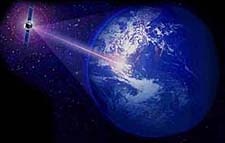
This groups includes about 200 communication satellites ("comsats") scattered in synchronous orbits above the Earth's equator. At a distance of 6. 6 Earth radii (42,000 km or 26,000 miles), these satellite make one orbit per day, (sidereal day of 23 h 56 min--see here) and therefore as the Earth turns, they always stay above the same ground station. Comsats have become essential to the relaying of television broadcasts, long distance telephone connections and computer communications: if you are receiving this from the world-wide web (especially if you are outside the US) this document might well have been routed to you through one of them. |